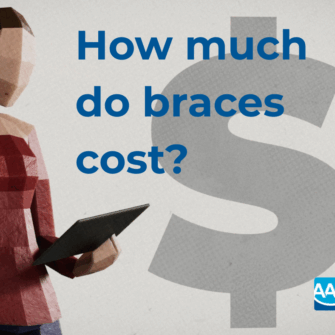Retainers Are Part of Treatment
Whether you’re considering orthodontics or currently undergoing treatment, you may be wondering, “Will I need to wear retainers after treatment?” The short answer is yes; while getting straight teeth is the goal, it’s only half the battle. The other half is keeping them straight, and that is where retainers come in.
Your teeth naturally move and change position throughout your life, and even after orthodontic treatment, they can continue to shift. To maintain the results created by your treatment, you must wear retainers. While minor changes after treatment are normal, retainers help prevent teeth from reverting to their original positions.
Retainer Wear Explained
The Importance of Post-Treatment Retainers
How Long Should You Wear Retainers?
Why You Need to Wear Retainers: An Overview
Your teeth may shift after treatment: Your teeth will attempt to return to their original positions after treatment, as no pressure is being applied to them.
Retainers keep your teeth from shifting: To keep your smile from moving, you’ll wear retainers. Your orthodontist will guide you on the best type and timing for your specific needs.
You may not be able to remove your retainer: If you had a significant malocclusion, your doctor may recommend a fixed or bonded retainer to provide your teeth with continuous support.
You will need to wear retainers for life: You’ll be required to wear retainers to some degree for the rest of your life to keep your teeth from moving.
The Importance of Post-Treatment Retainers
After the active phase of orthodontic treatment, retainers are prescribed for two reasons:
- Allow the bone and soft tissue that hold the teeth to “remodel” after the teeth have moved
- Maintain the healthy new positions of teeth
Your body changes your whole life, and your teeth change too. They have a natural tendency to shift back to their original positions, even after orthodontic treatment. Retainers are custom-made devices that prevent this shift, ensuring your teeth remain in their new, correct alignment.
Braces and aligners exert force to move teeth into the desired positions, which means the surrounding bone and soft tissues need time to stabilize around this new alignment. Without a retainer, the teeth can revert to their previous positions, undermining the time, effort, and funds invested in orthodontic treatment.
Available Retainer Options
When you finish active treatment, your orthodontist will recommend the best retainer for your unique smile.
There are two general categories of retainers:
- Removable: These are put in place by the patient and can be taken out.
- Fixed: These are bonded in place by the orthodontist.
Both types of retainers hold teeth in their new positions after “active” orthodontic treatment is completed.
Removable vs. Fixed Retainers: A Comparison
| Feature | Fixed | Removable Wire | Removable Clear |
|---|---|---|---|
| Can be removed by the patient | ❌ | ✅ | ✅ |
| Provides continuous support | ✅ | ❌ | ❌ |
| Virtually invisible | ✅ | ❌ | ✅ |
| Prevents teeth grinding at night | ❌ | ❌ | ✅ |
| Easy to clean outside the mouth | ❌ | ✅ | ✅ |
| Can’t be lost | ✅ | ❌ | ❌ |
| May require extra effort when flossing | ✅ | ❌ | ❌ |
| Susceptible to heat damage | ❌ | ❌ | ✅ |
| Most reliable for patient compliance | ✅ | ❌ | ❌ |
Removable Retainers
Removable retainers come in two varieties: wire retainers and clear retainers. Each type has its own unique features and benefits:
- Wire retainers, also known as Hawley retainers, are made of wire and a plastic-like material. The wire runs across the front of the teeth, and the acrylic base fits snugly on the roof of the mouth or behind the lower front teeth.
- Clear retainers are transparent trays made of a plastic-like material that are exact replicas of the teeth. These invisible retainers are similar in appearance to clear aligners, and many patients find clear retainers more comfortable due to their smooth and snug fit. Besides holding the teeth in place, clear retainers can also act as a protective barrier for teeth grinding during sleep.
Choosing between wire and clear retainers is often a conversation to have with your orthodontist. It’s likely that your orthodontist will have specific recommendations. If you have personal preferences, make sure to discuss them with your doctor. Your orthodontist will also teach you how to insert, remove, and take care of a removable retainer, including cleaning tips and proper storage.
Fixed Retainers
A fixed retainer consists of a thin, custom-fitted wire that is bonded directly to the inner surface of the upper or lower teeth. This wire stretches across several teeth and is typically made from stainless steel or titanium. The retainer is glued to the teeth by an orthodontist using dental adhesive, similar to the material used when braces are applied.
Since they are bonded to the teeth, fixed retainers provide continuous support, preventing them from shifting back to their original positions, they are also virtually invisible due to the wire being attached to the back side of the teeth, and you don’t have to worry about remembering to take them out.
These retainers are ideal for patients who have had significant alignment issues before orthodontic treatment or for those who don’t want the burden of remembering to take care of removable retainers. However, it’s essential to discuss your options with your orthodontist, as fixed retainers are a long-term commitment and may be harder to clean.
How Long Should You Wear Retainers?
Retainers are typically worn immediately after active treatment ends and then gradually reduced to nighttime wear, as instructed by your orthodontist.
As long as you want to keep your teeth straight, many patients wear retainers nightly for life. Ongoing retainer use is vital for preserving the aesthetic and functional benefits of orthodontic treatment, ensuring you enjoy a straight, beautiful smile for a lifetime. Luckily, wearing retainers can easily become part of your oral hygiene routine: brush and floss before bed and wear retainers at night.
Achieve Your Best Smile with an AAO Orthodontist
Orthodontic treatment can give you the smile you’ve always dreamed of at any age, but to preserve the results, it’s essential to wear your custom-fitted retainers. An AAO orthodontist can help you find the right treatment plan and the best retainer for your unique teeth. When you choose an AAO orthodontist for treatment, you can be assured that you have selected a highly skilled specialist.
To take the first step toward a healthy, beautiful smile, find an AAO orthodontist near you and schedule your consultation today.



